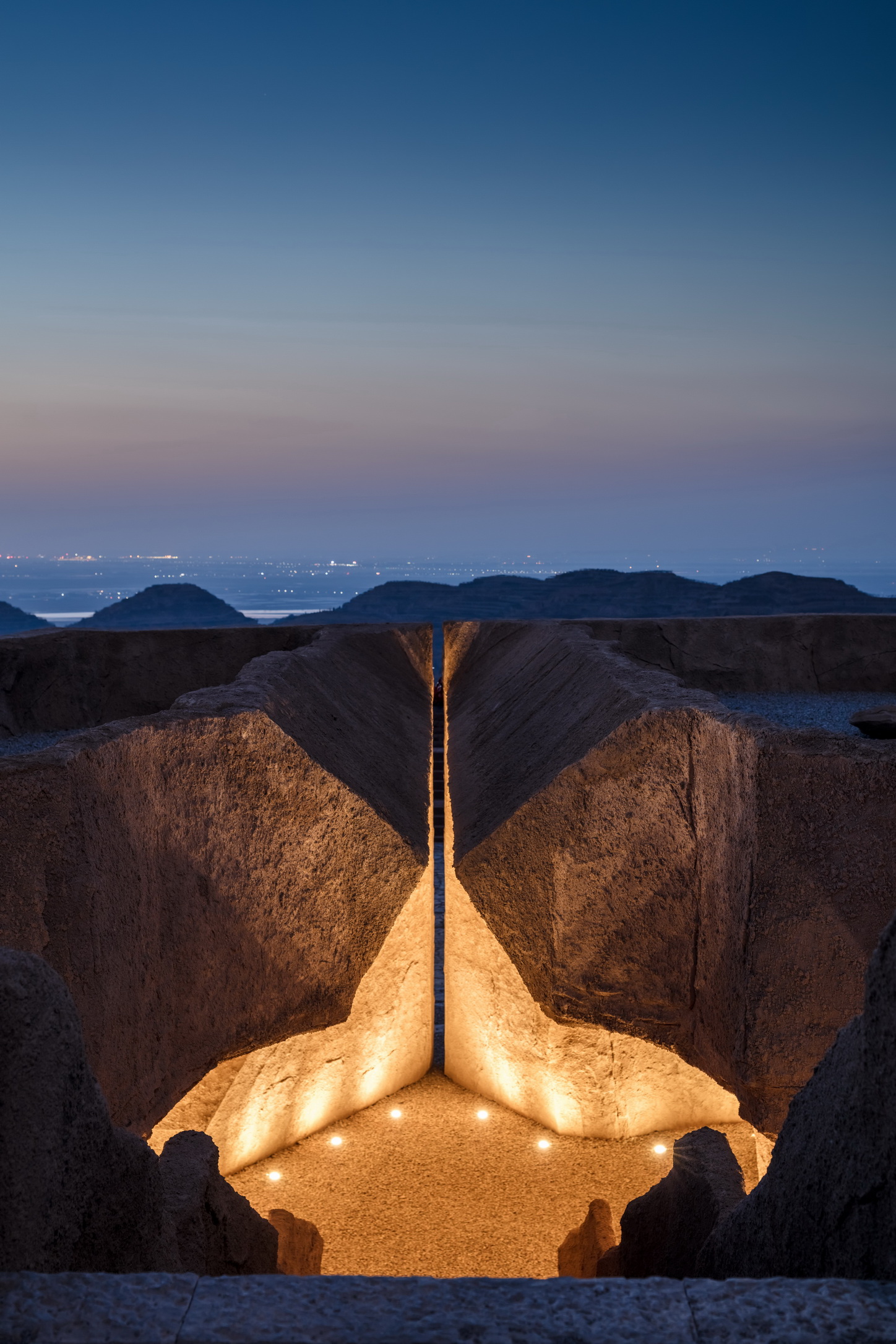Team: Li Yali, Wang Kun, Li Yongcai, Wang Lei, Gao Zixu, Liu Tong
Xihoudu historical site is located in Ruicheng County, Shanxi Province at the junction of Shanxi, Shaanxi and Henan provinces. This location is not only the cradle of the Yellow River civilization, but also one of the most important archaeological sites of ancient human activities. Found in late 1950s, here remains the vestige of fire firstly used by human beings about 1.8 million years ago. In 1988, Xihoudu was enlisted as one of the national 1st class cultural relics by the State Council.
In 2016, the Shanxi provincial government built a Holy Fire Plaza for a public torch relay circulating the province. However, the kitschy design is a damage to this holy site.
In 2017, The 2nd Youth Games of the People’s Republic of China was planned to be hosted in Shanxi in 2019, and the program of the flame gathering called for the re-use of Xihoudu Holy Fire Plaza. The challenge is to design something new without dismantling the existing facilities. To fulfill this requirement, as well as to integrate the artificial plaza with the surrounding landscape, the new design aims to make a mystical, spiritual and philosophical place, and to reinterpret the ancient Chinese belief of achieving the ultimate harmony between the nature and the man.
Technique-wise this design is innovative in terms of its material and construction method. The fast-track construction and the severe cold weather condition promote a creative usage of GRC material with both off-site prefabrication and on-site manual form-shaping construction methods. The innovative GRC technique mimics not only the materiality of the local Loess Plateau, but also its texture, and helps to make a harmonic dialogue between the built-form and the natural environment so as to re-install the spirit of place overriding the previous senseless design.
The new holy fire plaza is planned in the principles of making a favorable tourist spot by means of earth art without disturbing the archaeological stratum. With the three sequential narratives of “discovery of fire”, “rite of fire”, and “conquest of fire”, these designated themes from the east to the west of the site not only conform to program of the sports game ceremony, but also form a space-time context for visitors to enjoy the unique nature and the history.
The tour begins from the existing small archaeological museum at the hill foot, and ascends on the stone steps leading to a cave entry.
The cave of “discovery of fire” is indeed an artificial one to house the structure of the former fire seed collecting stage. The easier exterior shape of the cave is formed by factory prefabricated panels, while its interior is sculpted on site by hand to follow the irregular design. The cave is a semi-enclosed room which can be further developed into an exhibition space. The cave takes the visitors away from the modern setting and enter into a primitive one. The discovery of fire is a groundbreaking milestone in human civilization. This historical moment is illustrated with a split of seam cutting through the cave to bring the light from the heaven. Too much imitation of the natural form would devalue the artistic quality, therefore this “thin strip of sky” is a very artificial measure, meaning that human beings have totally changed their identity as the “fire-stealer”. A carefully calculated angle made it possible to light the fire during the time of holy fire seed collecting from the sunlight beam casting through the split on that ceremonial date. Another art installation in the cave is the interactive sound devices hung in the cave ceiling. After conquering the fire, human beings could be capable of living in the dark and deep caves to escape from outdoor dangers and inconveniences. This makes them turn shouts into whispers, and hence lose the joy of yelling. This acoustic installation is designed to allow visitors to make voices of whatever they want in a semi-closed capsulated space that connects the heaven and the earth.
The “rite of fire” on the open place recycles the previous stones for the boundary of the plaza to create more stands encircling the existing singular octagonal stand in the center. The stepped new stands refer to the surrounding topographic features, and also function as viewing platforms and seats for the surrounding sceneries. Besides archaeological value, Xihoudu historical site also has great landscape value as it is the best viewing place for Mountain Hua and the Yellow River.
This project also manages to recover the construction leftover in 2016 on the west side. The strategy is to have minimum input to achieve maximal gain in terms of time and cost. This idea is to roughly level the grade and dig trenches to minimally interfere the site. The result is a maze-like passage system, referring to archaeological digging, lead to the viewing decks overlooking the downhill archaeological site, and a path to descend to the lower place. This is also a symbolism of the journey of human’s “conquest of fire”. In the future, this place will become an open outdoor museum.
China is a country with a great collection of cultural and natural wonders. However, the presentational means for such heritages are always conservatively outdated. The design for the Holy Fire Lit Place for the Second China National Youth Games 2019 at Xihoudu Archaeological Site is an effort to change this situation by taking the advantage of a national event. A live TV broadcasting not only has presented a contemporary design for a historical site under the focus of the national wide audience, but also aroused a hot debate focusing on how to make an innovative presentation for time-honored cultural heritages.
Credits:
Project Location: Ruicheng County, Shanxi Province
Design Period: 2018
Construction Period: 2018-2019
Site Area: 11,056㎡
Floor Area: 980㎡
Client: The Government of Ruicheng County
Collaborators:
Art Consultant: Mou Sen | Ma Yuanchi, Mei Yuezi
Structural Design: H&J International | Li Yongming, Zhao Yanguo
Contractors: Shanxi Xijian Group Co., Ltd. (General Contractor)
Beijing Baogui Stone Art & Scientific and Technological Co.,Ltd. (GRC Supplier)
Beijing Huayun Garden Engineering Co., Ltd (Interior Finish)
Photographers: Cao Baiqiang, Zeng Tianpei
Awards:
2022 Achitizer A+Awards Architecture+Environment Category (Finalist)
2021 Blueprint Awards Public-Use Project with Public Funding (Finalist)
2020 THE PLAN AWARD Landscape Winner (Completed)
Project Publication:
URBANUS. Xihoudu Relics Ceremonial Flame Park. Architectural Practice 2020(06):144-151
URBANUS. Holy Fire Lit Place for the 2nd National Youth Games 2019 at Xihoudu Archaeological Site. Architectural Journal 2020(11): 60-65

